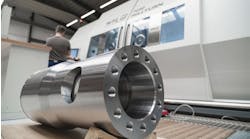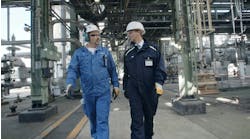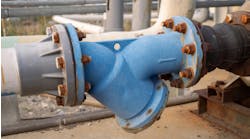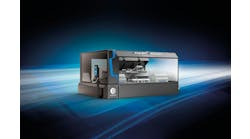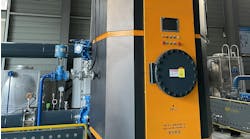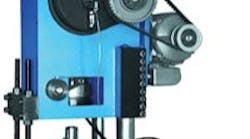Adiabatic technology also offers the advantage of forming material that cannot be formed cold with conventional methods. This results in more consistent quality and increased efficiency.
The Adiabatic Metal Forming process and press system from LMC Inc. (www.lmcpress.com) is available for producing high-quality blanks from practically any metal, forming them into net or near-net shaped parts with virtually no limitations in material, size, or form, and with no or limited need to preheat the material.
The process is based on the adiabatic softening phenomenon, discovered during World War II when scientists observed that piercing armor plates at high velocities produced clean holes with little distortion to the surrounding material. The phrase "adiabatic softening" refers to the process in thermodynamics when metal is deformed with no heat loss to the surroundings.
To apply this phenomenon in manufacturing settings, LMC engineered and patented a mechanical adiabatic unit that successfully creates the necessary acceleration speed. Whereas conventional metal forming/forging presses typically reach closing speeds from 0.5 to 5.0 meters/second, LMC's adiabatic press systems produce controllable speeds up to 100 meters/second, which creates the condition for this phenomenon. The result, according to LMC president Gordon Goranson, is more consistent quality and increased efficiency.
LMC's "Adiabatic Solution" starts with automated, adiabatic cut-off equipment that provides precision blanks to mass tolerances down to 0.2% or less, ideal for closed-die forging operations. This is significant given the increasing costs of material – providing blanks to specific mass without the loss of kerf. End quality of these blanks reportedly is excellent, without burrs, and ready to be forged. The absence of strain hardening allows the material to flow easily into the cavity.
The Adiabatic process can cut blanks from 1 to 100 mm in most metals in cold state. Cycle rates are dependent on diameter, but considered extremely high.
The process eliminates shear marks, and therefore the quality and appearance of finished parts improves after forging. Because the blanks are consistently produced to tight tolerances, die life is extended, and secondary operations are reduced since there is no flashing.
This entire process is a twostep operation that begins material is fed from coil or bar stock into an adiabatic cut-off station.
In less than a millisecond, a high-quality precision blank is produced with consistent length/mass tolerance, at a high cycle rate, without burrs, strain hardening, micro-crack formation, smoke, or material waste.
During the second step, the blank is transferred into the adiabatic forging station where, once it is positioned in the cavity of the forming tool, it is transformed into a net or near-net part in milliseconds. The material flows tightly into the die cavity. When the press ram accelerates the die, heat is generated, and localized softening occurs adiabatically due to the extreme energy concentration in time and space. Immediately after completion, the part is ejected, with virtually no time for heat transfer into the forming tool.
Adiabatic technology also offers the advantage of forming material that cannot be formed cold with conventional methods. In addition, the adiabatic process is environmentally friendly and energy efficient, with electrical energy requirements less than 15% of conventional blanking and forming methods.
LMC Inc., headquartered in DeKalb, IL, provides systems for metalworking, based on adiabatic process manufacturing, as well as turnkey systems to process blanks.

